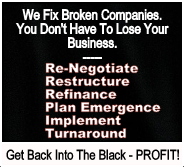Maximizing profits (within ethical, legal and quality control parameters) is one of the very fundamental objectives of an for-profit enterprise. Yes, we'd like to build value for stakeholders, mitigate and contain risk, and meet other objectives -- but none of these can be attained without profit maximization.
As a working tool for any professional involved in either starting, building or improving a business, I have distilled a rather extensive process into seven simple keys. While this list is by no means all-inclusive, it provides what I believe is an excellent analytic, evaluative and planning framework. These keys may be customized to suit the particular needs of your enterprise or industry sector.
We aren't speaking of Six Sigma or anything else which is technical or which requires significant training and possible certification. We are just utilizing common sense (logic) and a systematic means of organization. If the table which follows seems elementary to you, that's fine. Then simply ask yourself, "Am I implementing these steps?" If the answer is no, then consider this article a call to action.
Here are the SEVEN STEPS [Note: you may wish to increase the magnification of your screen in order to make the rather fine print somewhat easier to read in this table]:
---------------
SEVEN STEPS TO INCREASED PROFITABILITY
For Use In Planning, Evaluating And Re-Engineering For-Profit Companies For Success.
Copyright 2012 by Douglas E. Castle
IMPORTANT NOTE: The Term “Profitability” As It Is Used Below Means “Incremental Revenue Increase” or “Incremental Expense Decrease”.
| NUMBER | DESCRIPTION AND ACTION | BRIEF EXPLANATION AND SIMPLIFIED EXAMPLE |
| 1 | Maximize profitability per square foot or cubic foot of space. | Explore how much profit your physical premises generates, and find means of increasing it through productivity and efficiency increases, ergonomically, logically, and otherwise. If you work entirely in cyberspace, this might not apply to you. |
| 2 | Maximize profitability per “run” or “cycle”. | If your production works in shifts, cycles or runs, explore how much you can increase profitability per operation through minimizing waste, exploiting byproducts, better machine and personnel utilization and application, etc. |
| 3 | Maximize profitability per every dollar invested (every single dollar spent!). | For every dollar invested for any reason, explore and attempt to maximize the return which it yields. The mindset here is to look at every dollar or currency unit expended as an investment which must be justified by the return it generates -- no expense should be overlooked or simply assumed to be recurring or unavoidable. Remember “Zero-Based Budgeting?” This is an approach to doing that latter process dynamically and in increments. |
| 4 | Maximize profitability per hour overall. | Your business is open, or possible to be open , 24 hours per day, seven days weekly. If you are real-estate based, this might mean looking at taking on subcontracted work, running more shifts, or subletting some space. |
| 5 | Maximize profitability per asset category. | Divide your business assets into general categories such that every asset is categorized. Then look at each category with a view toward eliminating waste, redundancies, creating better interconnectivity and synergies. |
| 6 | Maximize profitability per campaign or event. | If you are issuing a press release, running commercials, having a contest, issuing discount coupons. |
| 7 | Maximize profitability per customer or per client relationship. | This is a marketing and CEM (Customer Expectation Management) Issue. It would seem to be self-explanatory, but it warrants serious evaluation, in terms of customer engagement, customer acquisition, customer satisfaction, customer retention, customer referrals, as well as TQM and product/service differentiation. |
| Do not be "turned off" by its inherent simplicity. The 7-step chart above is based upon timeless, success-proven fundamentals and will, at very least set your mind on the proper course for thinking about the components and the decisions that account for any business or project's success or failure. If you can use this chart on a team-based evaluative or planning effort, so much the better. | |||||











No comments:
Post a Comment